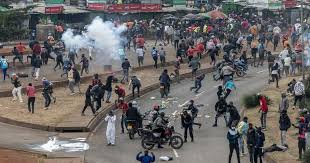At least 10 people have been confirmed dead and dozens injured as anti-government protests in Kenya took a violent turn, sparking outrage across the country.
The protests, largely driven by frustrated young people, have swept through several cities, marking another chapter in Kenya’s growing wave of youth-led unrest. The demonstrations coincided with the 35th anniversary of the historic Saba Saba uprising, an event that paved the way for Kenya’s multi-party democracy.
What started as peaceful protests quickly spiralled into chaos as police responded with tear gas, live bullets, water cannons, and razor wire barricades to block protesters from accessing key government buildings.
The Kenya National Commission on Human Rights (KNCHR), a state-run agency, condemned the heavy-handed response, accusing police of using excessive force and even colluding with armed thugs to silence the protests.
According to Ernest Cornel, spokesperson for the Kenya Human Rights Commission, over 25 armed men arrived on motorbikes in some areas, looting valuables and threatening people with chants of, “There will be no protest today.”
The unrest left many commuters and travellers stranded, with several schools advising students to stay home for safety. Human rights groups reported that plainclothes police officers were seen working alongside criminal gangs in various parts of the country, including Nairobi, Kajiado, Nakuru, Kiambu, and Eldoret.
The KNCHR documented at least 29 people injured, 37 arrests, and two suspected abductions during Monday’s protests.
In Kangemi, on the outskirts of Nairobi, Eagle Nursing Home confirmed that two bodies with gunshot wounds were brought in as hundreds of angry protesters gathered outside, demanding the release of the bodies.
Fires and road barricades were also reported in Nairobi’s Kamukunji area, near the original Saba Saba protest site, and in Meru County, where a shopping complex was set ablaze.
Despite government efforts to contain the unrest, clashes broke out in at least 17 of Kenya’s 47 counties.
Former Prime Minister Raila Odinga, who himself was arrested during the original 1990 Saba Saba protests, condemned the current crackdown in a strongly worded statement. His planned appearance at the protests was cancelled due to security concerns.
“These rogue officers are remnants of a colonial-era force,” Odinga said, calling for a national dialogue on police reform and an end to impunity.
Protesters who attempted to gather in central Nairobi were met with roadblocks stretching up to 10 kilometres from the city centre, effectively shutting down access.
Observers say this movement is fast turning into a generational uprising, fueled by young Kenyans tired of corruption, rising unemployment, and deepening inequality.
The Saba Saba movement, first launched on July 7, 1990, remains a powerful symbol of civic resistance in Kenya. The original protests led to the deaths of at least 20 people, but eventually forced the government of President Daniel Arap Moi to embrace democratic reforms after years of one-party rule.




